
Ocean Pasture Restoration Will Immediately Resolve Methane Crisis
Massive Runaway Methane Derives From Natural Methane And Collapse Of Natural Ocean Counterbalance
Many “scientists” are hustling to proclaim this is a mystery that demands more research dollars before anything might be done
Au Contraire Mon Capitan … The primary control of methane in the atmosphere is isoprene … The primary source of isoprene on this blue planet is … may we have the drum roll please … Ocean Plankton Pastures!
Sadly ocean pastures and their isoprene have been in cataclysmic decline over the same time frames in the reports of methane rising … the immediate solution … Ocean Pasture Restoration
The graphic at the top comes from a fine paper illustrating how chemicals (isoprene included) respired from ocean plankton pastures normally control atmospheric methane. But failing ocean pastures are no longer producing their historic amounts of these vital chemicals. Ocean plankton pastures have been decimated over the past many decades. As ocean plant life (and biodiversity) has collapsed one key part of global ecology and climate change is in trouble – atmospheric methane. The collapse of ocean pasture health results directly in the collapse of atmospheric methane control.
Ocean Pasture Restoration (Respiration) to the rescue, by restoring ocean pastures using our proven methods we will immediately restore this blue planet to its more beneficial blue-green tone. You may read everywhere on this blog just how our nature-based miracle works!
Methane rising and with it, the global warming tipping point is now perilously near. What if the problem is not more methane and instead loss of the natural methane control mechanism that healthy ocean pastures produce?
Here’s how the OPR Solution Works
OPR is working to globally deploy our ‘Village Scale Solution’ to replenish natural iron-rich dust to many of the world’s most vital ocean pastures that today are in a desperate state of collapse. By replenishing the ocean’s vital dust photosynthesis will switch back into its most efficient modes and powered by the sun convert most of humanities yesterday’s legacy CO2 into new ocean life.
The amount of ocean life that has been depleted over the past many decades represents a loss of natural capacity for repurposing CO2 equal to billions of tonnes of CO2 that in a healthy ocean becomes phytoplankton that sustains the bottom of the ocean food chain; today that CO2 turns oceans into acid-washed lifeless deserts.
Humanities’ choice is horrifyingly simple – do we choose more death or more life!

The world recognized the importance of ocean pasture collapse and the need to understand its cause 50+ years ago, we’ve learned a few things!
Ocean pasture restoration is a body of work that derives from decades of government, institutional, academic, and private sector research. The USA put the first ‘ocean pasture satellite’ into orbit in 1978! So this field of science is not something new, our know-how derives from over 50 years of research (and development). This knowledge base provides a tremendous understanding of how ocean plankton pastures function to keep our blue planet environmentally safe, ecologically sustainable, and functioning with the kind of climate we have all come to expect and indeed require.
Get ready to Geek
In new reports coming to light this past week in the Journal Nature global methane has been shown to be rising at an alarming rate. Further, this global methane rise is shown to be most importantly driven by natural methane build-up, NOT fossil fuel industry emissions! That means that focusing exclusively on methane leaked by industry cannot solve the climate problem.
If one reads up on how Mother Nature regulates her methane it is immediately clear that she does so by working via her largest natural living system, the ocean pastures where 90+% of global oxygen is produced. Remember oceans cover 72% of this blue planet and all life there grows upon a foundation of phytoplankton that forms the base of the food chain. The amount of land on this blue planet that supports plant life is nearer to 14%, the rest being covered by lifeless Ice and rock.
Ocean pastures are the primary producers of the chemicals, like isoprene, that maintain and sustain the chemical climate ecology of our atmosphere! There is a natural oxygen system that relies on a balance between processes that produce oxygen, those that consume it, and those that avoid it. Methane is a largely an anaerobic process, one that is produced and sustained in the absence of oxygen. Methane, in perishingly low concentration, about 2ppm in the air, is a most potent Greenhouse Gas that has a hundred times the global warming forcing effect of our CO2 (today over 417ppm).

Whales by their very presence feeding in their ocean pastures tend and sustain those pastures… They work for food! Click to read more!
When Do We Need To Do Something? Right Now!
As our OPR projects start to deploy in 2023 we can expect an immediate restoration of the most potent methane oxidation power in Mother Nature’s ecological toolkit. The natural methane-destroying chemicals produced (evolved) by blooming plankton will instantly reverse the dire rise in atmospheric methane.
In the bargain, our restored ocean pastures will produce food to nourish and replenish fish populations. But don’t think all those fish, whales, seabirds and other marine life are just freeloaders that will be happy getting a free lunch… All of ocean life ‘works for food’ and their work is to tend and sustain their very own vital ocean pastures.
Introducing Isoprene – Mother Nature’s Most Powerful Methane Management Tool
The secret to atmospheric methane is a natural chemical that comes from life on this blue planet called Isoprene. “Isoprene (2-methyl-1,3-butadiene) emissions by marine plankton are altogether of a magnitude similar to the sum of natural and anthropogenic emissions of methane1,2, ca. 500 TgC year−1.” Isoprene is formed naturally in animals and plants and as a matter of interest is generally described as the most common hydrocarbon found in the human body (and most living things.) Humans aren’t sensitive to the presence of isoprene, but dogs with their incredible sense of smell find it easy to identify and can be trained to alert their owners about dangerous changes in isoprene and their health!
The American Geophysical Union (AGU) is backing the scenario that Isoprene is the key! Methane’s rise they report may come in part from a drop in hydroxyl, a chemical that acts as an atmospheric detergent. Ocean isoprene is the top source of planetary hydroxyls. Isoprene is directly related to the amount of chlorophyll present, hence less chlorophyll = less isoprene = less methane destroying hydroxy = methane rising in the atmosphere. Of course the converse is also true!
 Hydroxyl radicals are present in tiny quantities and have a lifetime mere seconds, but even so they remove about 85 percent of methane from the atmosphere. One scientist notes, “They are the Pac-Man of the atmosphere. As soon as they see something, like methane, they eat it and then disappear.”
Hydroxyl radicals are present in tiny quantities and have a lifetime mere seconds, but even so they remove about 85 percent of methane from the atmosphere. One scientist notes, “They are the Pac-Man of the atmosphere. As soon as they see something, like methane, they eat it and then disappear.”
The research reports made good use of the global COVID lockdown to show OH concentrations decreased by around 1.6 percent in 2020 from the year before. The link to the drop in OH radicals is human air pollution in the form of nitrogen oxide (NOx) emissions which dropped dramatically during the COVID lockdowns. The 20 percent reduction in NOx correlates to a decrease in OH radicals which in turn results in an increase in methane to twice as fast as normal, one of the scientists told a press briefing, adding: “This has surprised us greatly.”
We Must Have A Sufficient Solution Now!
With the massive collapse of ocean primary productivity, aka pasture blooms, there is little reason to look elsewhere for solutions to mitigate the global methane rise. The ocean science world is in uniform agreement that the least case scenario for ocean plankton pasture collapse over the past 100 years is at least 1% per year. Similar agreement supports a ~50% decline since 1950!
There is a raging academic debate going on in the past year over whether reports that 90% of the North Atlantic Ocean plankton have been eradicated!
Whether the 50% global decline or 90% Atlantic decline is the correct number is more than a bit irrelevant – either number is truly catastrophic!!! And that’s without our discussion here of how healthy oceans are required to curtail the rise of global methane.
OPR will simply, coincidentally, and immediately solve the methane crisis as it brings back the fish!
It will be relatively simple for OPR to quantify its methane reduction by the measurement of our OPR isoprene production and instantaneous methane reduction. With the news about skyrocketing methane, the world needs our nature-based ocean pasture ‘isoprene’ restoration work.









